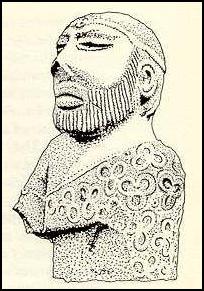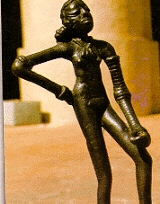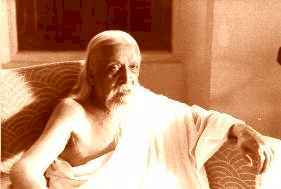|
Page < 1 2 3 4 5 6 7 8 9 10 11 12 13 14 15 >
Background
on Aryan Invasion Theory
 According to author
Bansi
Pandit author of The Hindu Mind: According to author
Bansi
Pandit author of The Hindu Mind:
"The Aryan Invasion Theory was put forth by Western
scholars, many of whom were Christian missionaries or whose scientific reasoning
was influenced by religious overtones. The Western
scholars (who were mostly Christians) believed in Biblical chronology, according
to which the world was created in about 4,000 BCE. Thus they rejected outright
any literary evidence in the ancient Hindu scriptures that pointed to dates and
events earlier that 4,000 BCE.
Max Mulller, as a Christian himself, believed
that the world was created around 4,000 BCE, as endorsed by Biblical chronology.
He thus arbitrarily assumed the time interval for development of each Veda to be
at 200 years. Any time period assumed to be greater than 200 years would have
pushed the date of the composition of the Vedas earlier than 4,000 BCE. thus
conflicting with Max Muller's religious belief about the creation of the world.
Knowing that Buddha lived around 500 BCE and that the Vedas were composed prior
to Buddha, Max Muller calculated the date of the arrival of Aryans in India as
500 BCE + 200 years (per time interval) x 5 (time intervals) = 1500 BCE.
The Vedas often speak of the war between
"the forces of light" and "the forces of darkness." Although
these expressions are only poetic metaphors (to
illustrate a war between virtue and evil) in the Vedas, they were
nevertheless interpreted as by Western scholars to indicate a war between
light-skinned Aryans and dark-skinned Dravidians. Thus it was concluded that
India was invaded by Aryans who destroyed the supposed pre-Aryan Indus Valley
culture. Current archaeological data have revealed that the Indus Valley culture
was not destroyed by any outside invasion, but by natural causes, such as
seismic events and floods.
Also, the correct translation of the Sanskrit
term samudra is ocean, it was initially
translated as "a body of water." Hence the references to ships in the
Rig Veda and to the river Saraswati (and other ancient rivers) were considered
false and mythical by Westerners. If samudra had been translated correctly as
ocean, the references to ships and the vast trade over water would have been
considered real and not mythical, and would have also indicated that the Aryans
were civilized people and not nomads. The idea of nomadic Aryans had been
assumed by Western scholars to fit their idea of the Aryan invasion.
The Implication of the Aryan
Invasion theory is that it declares the Vedic culture to be primitive. The
Puranas, Mahabharata, and Ramayana are labled as mythical and approximately
7,000 years of Vedic culture are left without any historical basis. It
creates a rift between the North and South. Also that Vedic culture was
subsequent to the Middle-Eastern culture, which are historically linked to the
Bible and Christianity.
(source: The
Hindu Mind: Fundamentals of Hindu Religion and Philosophy for All Ages
- By Bansi Pandit B & V Enterprises 1996. page
312-315).
Watch
Scientific
verification of Vedic knowledge
 Koenraad
Elst, (1959 -) Dutch historian, Belgian scholar, has said that: Koenraad
Elst, (1959 -) Dutch historian, Belgian scholar, has said that:
"Until the mid-19th century, no Indian had
ever heard of the notion that his ancestors could be Aryan invaders from Central
Asia who had destroyed the native civilization and enslaved the native
population. Neither had South-Indians ever dreamt that they were the rightful
owners of the whole subcontinent, dispossessed by the Aryan invaders who had
chased them from North India, turning it into Aryavarata, the land of the
Aryans. Nor had the low-caste people heard that they were the original
inhabitants of India, subdued by the Aryans and forced into the prison house of
caste which the conquerors imposed upon them as an early form of Apartheid.
All these ideas had to be imported by European scholars and missionaries, who
thought through the implications of the Aryan Invasion Theory (AIT), the theory
that the Indo-European (IE) language family had spread out from a given
homeland, probably in Eastern Europe, and found a place in Western and Southern
Europe and in India as a cultural luggage of horse-borne invaders who subjugated
the natives."
(source: Update
on the Aryan Invasion - Dr. Koenraad Elst)
Overrunning Asia in the wake of its nascent
imperialism in the 18th century, Western scholars ran berserk propounding
half-baked theories and forcing mistaken thesis on the subjugated peoples of the
world. One such mistaken notion forced on a psychologically supine world was the
phantom of a so-called 'Aryan race.' This shadow-chasing was bound to result in
nothing but utter confusion and total failure because blundering Western
scholarship has raised the phantom of the so-called 'Aryan Race' out of its own
imagination caused by a basic misunderstanding of the Sanskrit term 'Arya.'
Sanskrit-speaking Indians have coined the word 'Arya'
to signify and ideal. To the Indians an 'Arya' signified a thorough bred ...a
perfect gentleman, an ideal person, a superman. Being great Idealists and
sticklers for purity of behavior they constantly referred to the 'Arya' concept
as a state of evolution to which every individual must aspire.
What better proof of this truth can be found than
the well known maxim which enjoins on all Indians the ideal "KRUNVANTO
VISHAM ARYAM" ie "MAKE THE
ENTIRE WORLD ARYAN".
 Had the 'Aryan'
signified a race, the above dictum would not have come into being because
race-conscious people far from wanting to assimilate the 'world' in their fold
believe in maintaining an exclusive identity. Had the 'Aryan'
signified a race, the above dictum would not have come into being because
race-conscious people far from wanting to assimilate the 'world' in their fold
believe in maintaining an exclusive identity.
(Source: Some Blunders of Indian Historical Research -
By P.N. Oak Bharati Sahitya Sadan. New Delhi. p. 212-213).
"Upon the discovery of
the Indus cities, Aryan invasion theorists promptly scouted around for signs of
battles between the invading Aryans and the settlers of the Indus River. In a
late layer at Mohenjo-daro, archaelogists discovered the skeletal remains of
thirty-eight individuals in contexts suggesting violence. Hypnotized
by the Aryan Invasion theory, archaeologists summarily attributed the death of
these urbanites to a "final massacre" at the hands of marauding bands
of Aryan nomads."
(source: In
Search Of The Cradle of Civilization: New Light on Ancient India
- By Georg Feurerstein, Subhash Kak & David Frawley
p. 77-78).
One main reason that the theory has been called into question is that there is
no primary evidence. No monuments to any heroes of such invasions have been
excavated, no related cemeteries unearthed, no battle fields identified in
relation to the theory, no forts, in short- nothing in the way of physical
evidence. There is a host of other in congruencies, but this is the general
idea. What Western scholars have relied upon to substantiate the theory is etymology.
They trace linguistic patterns, encompassing the East and West, and then by
implication pinpoint a central geographic area which then serves as a common
point of origin of the Indo-European language and race. This point, being
basically the Caucasians and mountainous regions of Persia, is of course,
outside of India, such that the existence of the Aryan race in Northern India is
attributed to an invasion, and such is the flimsy explanation they offer for the
Caucasian presence in India.
It has often been pointed out that few other principal theories have ever been
accepted based on such indirect, flimsy evidence. When something ends up being
so rigidly imposed with such little basis, a reasonable mind will look for other
motives.
Again we may rely on the broad understanding of David
Frawley:
"It is important to examine the social and political implications of the
Aryan invasion idea:
 First,
it served to divide India into a northern Aryan and southern Dravidian culture
which were made hostile to each other. This kept the Hindus divided and is still
a source of social tension. First,
it served to divide India into a northern Aryan and southern Dravidian culture
which were made hostile to each other. This kept the Hindus divided and is still
a source of social tension.
Second, it gave the British an excuse in their conquest of India. They could
claim to be doing only what the Aryan ancestors of the Hindus had previously
done millennia ago.
Third, it served to make Vedic culture later than and possibly derived from
Middle Eastern cultures. With the proximity and relationship of the latter with
the Bible and Christianity, this kept the Hindu religion as a sidelight to the
development of religion and civilization to the West.
Fourth, it allowed the sciences of India to be given a Greek basis, as any Vedic
basis was largely disqualified by the primitive nature of the Vedic culture.
This discredited not only the 'Vedas' but the genealogies of the 'Puranas'
and their long list of the kings before the Buddha or Krishna were
left without any historical basis. The 'Mahabharata',
instead of a civil war in which all the main kings of India participated as it
is described, became a local skirmish among petty princes that was later
exaggerated by poets. In short, it discredited the most of the Hindu tradition
and almost all its ancient literature. It turned its scriptures and sages into fantasies
and exaggerations.
This served a social, political and economical purpose of domination, proving
the superiority of Western culture and religion. It made the Hindus feel that
their culture was not the great thing that their sages and ancestors had said it
was. It made Hindus feel ashamed of their culture - that its basis was neither
historical nor scientific. It made them feel that the main line of civilization
was developed first in the Middle East and then in Europe and that the culture
of India was peripheral and secondary to the real development of world culture.
Such a view is not good scholarship or archeology but merely cultural
imperialism. The Western Vedic scholars did in the intellectual sphere what the
British army did in the political realm - discredit, divide and conquer the
Hindus. In short, the compelling reasons for the Aryan invasion theory were
neither literary nor archeological but political and religious - that is to say,
not scholarship but prejudice."
(source:
Hollow
Earth Theory And The Aryan Invasion
- By
Dean De Lucia/Dharmapada Dasa).
 Shri
Aurobindo
wrote about European scholarship: Shri
Aurobindo
wrote about European scholarship:
"European
scholarship regards human civilization as a recent progression starting
yesterday with the Fiji islander, and ending today with Rockefeller, conceiving
ancient culture as necessarily half savage culture." It is a superstition
of modern thought that the march of knowledge has always been linear."
"Our vision of "prehistory" is terribly inadequate. We have not
yet rid our minds from the hold of a one-and-only God or one-and-only Book, and
now a one-and-only Science."
(source: The Invasion That Never Was
-
By Michel Danino and Sujata
Nahar p. 86-87).
(Note: In the Mosaic
system, the whole world just as we know, was formed
in the course of six days. Archbishop Ussher,
in the 17th century fixed the date as 4004 B.C. Later theologians
however, not being content with the specifications of the year alone, added
further refinements to their date-scheme and specified 9 am. of the 23rd
October, 4004 BC as being the exact hour, correct to the second, fixed in
accordance to the present G.M.T. This cosmogonic dogma of Christian theology
held a dominate place in Mediaeval thought even as late as the last century, due
to the influence that Christian theology has had on contemporary thought).
According
to Sri Aurobindo:
“We
are ready to accept all European theories, the theory of an 'Aryan' colonization
of a Dravidian India, the theory of Nature worship…as if these hazardous
speculations were on par in authority and certainty with the law of gravitation
and the theory of evolution.” “So
great is the force of attractive generalizations and widely popularized errors
that all the world goes on perpetuating the blunder talking of the Indo-European
races, claiming or disclaiming Aryan kinship and building on that basis of
falsehood the most far-reaching political, social or pseudo-scientific
conclusions."
(source:
The
Secret of the Veda - By Sri Aurobindo 1972
p. 4).
***
Samuel Butler said "God cannot alter the past, historians can." This
is the most effective way of emphasizing the need for research into the origins
of the Aryans. One of the major reasons why a
consideration of the idea of an Aryan invasion into India is prevalent among
some Western researchers is because of their
misinterpretation of the Vedas, deliberate or
otherwise, that suggests the Aryans were a nomadic people. One such
misinterpretation is from the Rig-Veda, which describes the battle between Sudas
and the ten kings.
Dr. Jonathan Mark Kenoyer,
in
his book, Ancient
Cities of the Indus Valley Civilization categorically
states that the decline of this ancient civilization was due to natural causes
and not because of destruction by invading nomads. He
makes a clear rejection of the Aryan invasion theory, which the distinguished
British anthropologist, Edmund
Leach,(1910-1981) has
termed a theory born out of European racism.
More information in this regard is found in article by
J.
F. Jarrige and R. H. Meadow in the August, 1980
issue of Scientific
American called "The Antecedents of
Civilization in the Indus Valley." In the article they mention that recent
excavations at Mehrgarh show that the antecedents of the Indus Valley culture go
back earlier than 6,000 B. C. in India. An outside influence did not affect its
development. Astronomical references established in the Vedas do indeed concur
with the date of Mehrgarh. Therefore, sites such as Mehrgarh reflect the earlier
Vedic age of India. Thus, we have a theory of an Aryan invasion which is not
remembered by the people of the area that was supposed to have been conquered by
the Aryans.
The Vedic literature is massive and no other culture has produced anything like
it in regard to ancient history. Not the Egyptians, Sumerians, Babylonians, or
Chinese. So if it was produced outside of India, how could there not be some
reference to its land of origination.? For the matter, how could these so called
nomads who came invading the Indus region invent such a sophisticated language
and produce such a distinguished record of their customs in spite of migrations
and numerous battles? This is hardly likely.
(source: Proof
of Vedic Culture's Global Existence - By Stephen Knapp p.
42).
Ramachandra
B.J. Rao
could dub this theory as "nothing but a varnished tale utterly undeserving
of the name of traditional history", an opinion which was echoed in
different ways by some other persons as well. It is gratifying to note that
people like Swami
Vivekananda, Aurobindo Ghosh and Dadabhai Naoroji did not have appetite for
racial theories, because, as Naoroji put it, they were unrealistic and often
used to prove the inferiority of Asians.
In
a perceptive essay Devendra Swarup (1926-1993)
Historian and Journalist, argues that after 1857 the British Imperial policy
tried to reconcile the Indian upper classes to the British rule and
"implement a policy of "Divide and Rule" by giving Indian
diversity and institutions a racial interpretation and to uproot all the bonds
of unity that had evolved through a very very long historical
journey."
One
does not grudge the British rulers of India their policy, but one may
justifiably ask why such a racist theory was accepted, some oppositions
notwithstanding, by all and sundry not merely among the Indian masses but also
among most of the professional historians and archaeologists till today. The
roots of Hindu bigotry do not lie in the glorification of ancient India but in
the historical acceptance of a demeaning racist theory which equated the history
of ancient India to that of Aryan colonization.
Page < 1 2 3 4 5 6 7 8 9 10 11 12 13 14 15 >
|